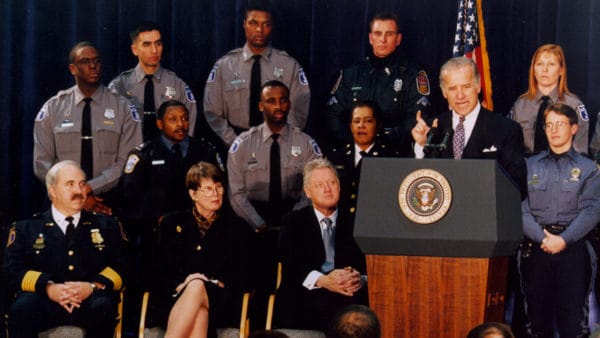Lauren Southern’s Wake-Up Call for Whites
John Jackson, American Renaissance, January 11, 2020
Filmmaker Lauren Southern has just released her third documentary, her most in-depth to date. Crossfire is about race, policing, rioting, and the alleged epidemic of police killings of innocent black men. Mrs. Southern does not take a race-realist position, but is still generally accurate.
The film begins with a discussion of 1960s United States. Then, as now, there was dramatic crime and rioting. Some blacks called the police their enemy, and whites lost sympathy for integration. Rioting and crime also led to greater support for law and order.
Mrs. Southern refutes the claim that poverty causes crime. She notes that in times of increasing prosperity, such as the 1920s and 1960s, there were sharp increases in crime. For years, New York City spent enormous sums on black, but crime rose.
Mrs. Southern explains that it is crime that causes poverty, because businesses and law-abiding residents move out. She also concedes that genetics explain between 40 and 80 percent of antisocial behavior, but Mrs. Southern talks more about environment. Fatherless teenagers are twice as likely to end up in jail. Former prison psychiatrist Marlin Newburn says a denial of personal responsibility is “endemic” among blacks; parents excuse even the most egregious behavior of their sons.
Mrs. Southern notes that in the 1960s, a lenient justice system encouraged crime — as it does today. Before 1980, “only 40 percent of individuals arrested for murder were sentenced to prison. Murderers served only an average of five years.” In 1981, fewer than 10 percent of suspects arrested for sexual assault went to prison.
After measures such as the 1994 Crime Bill, crime decreased dramatically for 20 years, but has started back up. Under pressure to cut prison populations, many cities have decided to make fewer arrests, which has led to more crime. The clearest benefit of prison is to prevent criminals from committing more crime, but this is forgotten amidst cries to abolish police and prisons.

Joe Biden (D-Delaware) speaks at the signing of the 1994 Biden Crime Bill as Attorney General Janet Reno, President Bill Clinton, and local law enforcement officials look on.
Crossfire notes a significant difference between the riots of the 1960s and those of today: the presence of antifa, a coalition of mostly white self-described anti-fascists and anti-racists.
Although Mrs. Southern’s team interviewed antifa activists, she says she found their comments banal and did not include them. Instead, several journalists and commentators explain antifa. Journalist Elijah Schaffer says they have tried to blind police officers with lasers and like to use explosives. Social commentator Jack Murphy describers the murder of Trump supporter Aaron Danielson by antifa activist Michael Reinoehl; his comrades celebrated the killing.
Mr. Schaffer explains the attraction of antifa. Terrorism gives a false sense of self-righteousness and an illusion of fighting tyranny. Bomb-throwers think they are heroic soldiers; otherwise, they would be nobodies. Mr. Schaffer notes the distinctly unhealthy look in antifa mug shots.
Deidra Rose Watts, 25, formerly known as David Villalpando Perez, of Vancouver, Wash., was arrested at the antifa gathering in north Portland. She’s part of the #antifa press crew & was quickly released without bail. #PortlandRiotshttps://t.co/9kkSQGeMkZ https://t.co/Bw2AvOHyK9 pic.twitter.com/9tAp4wfpos
— Andy Ngô (@MrAndyNgo) September 7, 2020
Explicitly anti-police BLM activist Hawk Newsome gets a lot of film time but so do some police officers. Several discuss their backgrounds, as well as the agonizing decisions on whether to open fire. One officer describes the emotional toll of being around violent crime and corpses. Criminologist John Paul Wright, the son of a police officer, describes how his father’s life was ruined by a brain injury when a criminal tried to kill him.
Mrs. Southern notes the high rates of black crime. In 2019, blacks were 8.2 times more likely than non-blacks to be known murderers. Over 7,000 blacks were murdered in 2019 and 2018. In 2018, 88 percent of the suspects who killed blacks were black.
For 2019, the Washington Post’s national database records only 14 unarmed blacks killed by the police. Blacks interviewed in the film believed police had killed at least 1,000. Police are 18 times more likely to be killed by a black man than an unarmed black man is to be killed by police.
One officer sheds light on another problem: Blacks don’t talk to the police. He remembers going to a murder scene in a black neighborhood and finding that none of the officers were talking to witnesses. He soon learned why. Only after asking “40 or 50 people” did he find someone willing to talk. Blacks refuse to “snitch,” even for serious crimes — because they fear other blacks, not the police.
Neighborhoods like that are effectively outside of the rule of law. Crossfire explains that police use technology known as ShotSpotter, which recognizes the audio signature of a gunshot and determines its location. Police need this because many shootings don’t lead to a 911 call.
Mrs. Southern discusses issues we are supposed to ignore. The racial angle is more explicit than in her earlier documentaries, and should help wake up white viewers to the racial and cultural crisis we face.















